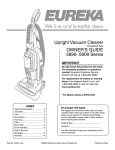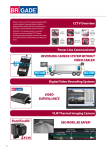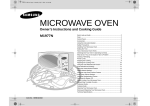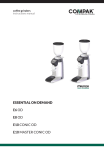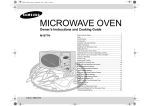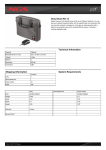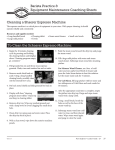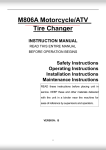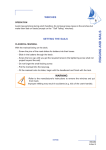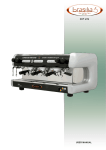Download GS3 Operating Manual (actual).indd
Transcript
!"#$%"$&'(#')*+,&#-& GS/3 Owner’s Manual Version 1.00 English !"#$%"$&'(#')*+,&#-& Thank you for purchasing this La Marzoco GS/3 Espresso machine. For information about your GS/3 or to find others to share information about the GS/3, please visit our website at www.lamarzocco.com. Here you will find a section dedicated to La Marzocco GS/3 users. To gain access you will need to register your product. For additional resources on espresso beverages and the processes for producing quality in the cup, please visit the numerous websites available on the internet. 1 Version 1.00 La Marzocco, S.r.l. Firenze, Italia GS/3 English Table of Contents General Information ..........................................................................................3 Accessories .......................................................................................................4 Machine Description .........................................................................................5 Installation..........................................................................................................6 Operation............................................................................................................8 Key Features ......................................................................................................9 Preventative Maintenance and Cleaning .......................................................10 La Marzocco History .......................................................................................13 www.lamarzocco.com Version 1.00 2 General Information English About this Manual 1. This operating guide is an integral and essential part of the product and must be supplied to users. Users are asked to read the enclosed warnings and cautions carefully, as they provide valuable information concerning safety during installation, operation, and maintenance. This manual must be kept in a safe place and be available for consultation to new and experienced users alike. Remove Machine from Packaging 1. Ensure product’s integrity by inspecting the packaging. Making sure it presents no signs of damage which might have affected the enclosed machine. 2. Check the machine’s integrity after having carefully removed the packaging. 3. Packaging (boxes, plastic bags, foam parts and whatever else) must not be left within easy reach of children, due to the potential danger it represents, nor be discarded in the environment. Safety Instructions 1. Check to see that data on the rating plate corresponds to those of the main electrical supply which the machine will be attached. 2. The installation must be performed according to local electrical and plumbing codes and regulations. The installation also must comply to the manufacturer’s instructions, and must be performed by qualified and authorized personnel. 3. Incorrect installation may cause injury/damages to people, animals or objects, for which the manufacturer shall not be held responsible. 4. Safe electrical operation of this device will be achieved only when the connection to the power outlet has been completed correctly and in observance of all local, national, and international electrical codes and safety regulations, and particularly by grounding the unit. Make sure grounding has been done properly as it represents a fundamental safety requirement. Ensure qualified personnel check such connection. improper and/or irrational use. 8. Using any electrical device requires that certain fundamental rules be observed. In particular: -do not touch the device with wet or moist hands and feet -do not use the device while not wearing shoes -do not use extension cords in bath or shower rooms -do not unplug the device from the power outlet by pulling on the power supply cable -do not expose the device to atmospheric agents -do not allow children or untrained people to use this device 9. Before performing any maintenance and/or cleaning operations (other than back flushing the group), turn the main switch to the “0” or OFF position, and disconnect the machine from the electrical network by unplugging the cord or by switching off the relative circuit breaker. For any cleaning operation, follow exclusively the instructions contained in this manual. 10. In case the machine is operating in a faulty manner or stops working, disconnect it from the electrical network (as described in the preceding point). Do not attempt to repair it. Contact a qualified and authorized professional to perform any repair. Any repair must be performed exclusively by the manufacturer or by an authorized centre using only original parts. Non compliance with the above could compromise the safe operation of the machine. 11. In order to avoid dangerous overheating problems, it is recommended that the power supply cable be unfurled completely. 12. Do not obstruct air intake and exhaust grilles and, in particular, do not cover the cup warmer tray with cloths or other items. 13. The machine’s power supply cable must not be replaced by users. In case the power supply cable becomes damaged, shut off the machine and disconnect the machine from the electctrical network by unpluging the power cord or switching off the relative circuit breaker and close off the water supply; to replace the power supply cord, contact qualified professionals exclusively. 5. Furthermore, you must ensure that the capacity of the available electrical system is suitable for the maximum power consumption indicated on the espresso machine. 6. We do not recommend using adapters, multiple plugs and/or extension cords. If you cannot avoid using them, make sure that they are exclusively of the kind which conforms to local, national, and international electrical codes and safety regulations, being careful not to exceed the power and current ratings indicated on such adapters and extension cords. 7. This device must be used exclusively for the functions it has been designed and built for. Any other application is inappropriate and dangerous.The manufacturer shall not be held responsible for any damages caused by 3 Version 1.00 La Marzocco, S.r.l. Firenze, Italia GS/3 Accessories 1. Accessories MODEL GS/3 QTY. 1 PART NO. L111/2N DESCRIPTION PORTAFILTER ASSEMBLY, DOUBLE SPOUT, LION 1 L111/1 PORTAFILTER ASSEMBLY, SINGLE SPOUT, LION 1 L115/C PORTAFILTER BASKET, BLIND 2 L115/A SINGLE BASKET - HAND TAMP 2 L116/A DOUBLE BASKET - HAND TAMP 1 L117 1 UT005 1 L037/2PGR 1 L325/L326 1 L309 ARMORED DRAIN HOSE, CLEAR 1 L312 HOSE CLAMP 2 L120/2A 1 V063 PLASTIC HAND TAMPER HEX KEY, 5mm DRAIN BOX HOSE BARB STAINLESS STEEL BRAIDED HOSE 1/4G TO 5/16"-24 UNF WASHER, FLAT, SEALING TYPE, M6 (12X6.25X0.75) ESPRESSO MACHINE CLEANER L115/A L115/C English Check the package to make sure that the following accessories are included in the packaging: L116/A V063 L120/2A L117 L111/2N L037/2PGR UT005 L111/1 L309 L325/L326 L312 Figure 1 - Accessories www.lamarzocco.com Version 1.00 4 Machine Description Group Head Group Cover English Cup Tray Main Power Switch Pressure gauge (Steam Boiler) Pressure Gauge (Coffee Boiler) Steam Wand Steam Activation Lever Display Keypad Hot Water Dispensing Spout Temperature Adjusting Knob for Hot Water Drain Box Figure 2 - Machine Description 5 Version 1.00 La Marzocco, S.r.l. Firenze, Italia GS/3 Installation Espresso Machine Installation, GS/3 5mm Hex Key 2. Connect Espresso Machine to Power Supply. Connect the espresso machine to a power supply that is rated in accordance with the serial plate on the espresso machine. English 1. Fill Water reservoir with Water. Remove the drain tray and slide the water reservoir until the water reservoir fill cover is accessable. Remove the cover and fill water reservoir with filtered water. Replace the fill cover and slide the water reservoir to the operating position and replace the drain tray. (See GS/3 Installation Guide for addition instructions) Bleed Screw 3. Filling the Boilers with Water. Once the espresso machine has been unpackaged, placed on a hard surface, and the water reservoir full, it will be necessary to fill the boilers with water. Complete the following steps to properly fill the boiler tanks: 4. Steam Boiler. Turn the main switch to position “1” or ON, the automatic steam boiler level system will be switched on, activating the auto-fill solenoid valve and the water pump. This will fill the steam boiler to a predetermined level and will shut off when full. NOTE: It may be necessary to re-fill the water reservoir during this process. Check to see if the “Water Tank Empty” error message is present on the display before continuing. 5. Coffee Boiler. The water flows inside the coffee boiler directly when the water pump is activated. When the GS/3 is turned on the electronics will activate the water pump to fill both boilers. Since the inflow of water will compress the air in the boiler it will be necessary to remove or “bleed” the air from the coffee boiler. All air must be removed in order to completely “saturate” the coffee boiler/group assembly. To remove the air from the boiler (“bleed the groups”) remove the group cover from the top of the group head. Then loosen the bleed screw (see picture) to allow air to escape until water flows from below the screw head. It may be necessary to activate the brew process by pressing button #5 (the continuous button) to force the air out of the group. Tighten the screw to stop the water from flowing. Over tightening can cause damage to the sealing washer and the group cap. If this sealing washer is damaged replace washer with one included in accessory kit. Once all air is removed from the coffee boiler, reinstall the group cover. For more detailed instruction please refer the GS/3 Installation Guide. NOTE: It may be necessary to re-fill the water reservoir during this process. Check to see if the “Water Tank Empty” error message is present on the display before continuing. 6. Verify filling of Boilers. The installation is now complete and the espresso machine should be heating to the operating temperatures. www.lamarzocco.com Figure 3 - "Bleed the Group" 7. Waiting for the Espresso Machine to Heat to Operating Temperature. During this time, it may happen that the pointer of the coffee boiler pressure gauge reaches as high as 12 bar. This may happen anytime that the heating element is in the on condition. If the pressure exceeds 12 bar then it will be necessary to adjust the expansion valve in such a manner that the pressure never exceed 12 bar. In normal operating conditions, the coffee boiler pressure gauge can read anywhere from 0-12 bar. When brewing, the pressure should be set to approximately 9 bar. When the espresso machine is ready to operate all lights on the keypads will light. Figure 4 - Key Pad buttons Figure 5 - Key Pad buttons with lights on NOTE: As the steam boiler reaches operating temperature you may hear air and steam escaping from the boiler. This is a normal sound. As the water boils, air in the boiler is replaced by steam and exits through the vacuum breaker. As the boiler get closer to operating temperature the vacuum breaker closes and the steam is no longer able to escape. This process allows the air in the steam boiler to escape and to be replaced by water vapor. Version 1.00 6 Installation English 8. Adjusting the Expansion Valve. The expansion valve is a component that limits the maximum pressure in the coffee boiler. Heating the coffee boiler causes the water within to expand. Since the coffee boiler is completly saturated, the expanding water causes an increase in pressure within the boiler. Without a safety device the increase in pressure could cause a rupture in the boiler. The pressure in the coffee boiler should never exceed 12 bar. To increase pressure rotate the expansion valve clockwise. To decrease pressure rotate the expansion valve counter clockwise (See the following diagram). NOTE: The water pump pressure should be adjusted when the machine is operating and coffee is present in the portafilter. Increase Pressure ! Decrease Pressure WARNING ! The expansion valve can discharge water as hot as 200°F / 93°C. Adequate protection for handling this component is needed before atempting to adjust. Figure 6 - Expansion Valve Adjustment 9. Adjusting Water Pump Pressure. The water pump is factory set at 9 bar pressure. If it becomes necessary to change the pressure please use the following procedure: 1. Remove the left side cover assembly. 2. Locate the water pump adjustment screw and loosen the lock nut. 3. Adjust the water pump pressure to the desired measurement. 4. Rotate Clockwise to increase pressure and counter clockwise to reduce pressure. Lock Nut Adjustment Screw Left Side Panel Assembly Water Pump Pressure Adjustment Screw Figure 7 - Water Pump pressure Adjustment 7 Version 1.00 La Marzocco, S.r.l. Firenze, Italia GS/3 Operation 1. Installing the Portafilters. Install the portafilter by inserting it into the group head and rotate the handle from left to right. Once the portafilter is inserted properly, you can press one of the brewing buttons on the keypad to start the flow of water through the portafilter. Please refer to the Software Programming Guide for a description of the functions of the keypad It is important that the portafilter is at operating temperature prior to filling with coffee. Allow hot water to pass through the empty portafilter for a few seconds before the brewing process to pre-heat the portafilter. Filter Basket Portafilter Handle Spout Figure 8 - Portafilter Note: It is important to leave the portafilter installed in the espresso machine when not in use. The portafilter must remain heated for the brewing process to function correctly. 2. Brewing Coffee. It is now possible to remove the portafilter to make a coffee beverage. Place some ground coffee in the portafilter basket using the single or double portafilter basket. Press down on the ground coffee with the supplied tamper and install the portafilter on the GS/3. Press a brew button to begin the brewing process. Note: Some users believe it is important to allow water to pass through the the group head prior to installing the portafilter to flush any remaining coffee oils and particles from the group head. Some also flush just after brewing to do the same. Please experiment to make the best possible procedure for your coffee. There are many techniques for brewing espresso. You can find instructions for many techniques on websites, blogs and forums. Some are even monitored by professional baristas around the world. The steam will transfer heat to the liquid raising its temperature. Be careful not to allow liquid to overflow in order to avoid severe burns. Steaming milk for cappuccino’s and other beverages is very easy but making it just right requires some skill. Please experiment with various techniques to find the best method for your milk. You can find many discussion about the steaming of milk on the internet. NOTE: It is important to have a sufficient volume of liquid in the steaming pitcher. Therefore if you intend to steam small amounts of milk it is necessary to use a small pitcher. If you intend to steam larger quantitles of milk then it is necessary to use a larger steaming pitcher. Using too little milk in a steaming pitcher can allow the milk to be “blown out” of the pitcher. A good rule to follow is to fill the steaming pitcher only half full of liquid. Note: In order to prevent the heated liquid from being sucked back into the steam boiler it is recommended that you purge the steam system after heating any liquid. Purge the system by opening the steam valve for a few seconds to allow steam to escape to the atmosphere from the end of the steam wand. Failure to do so can cause the heated liquid to transfer from the heated liquid container to the steam boiler (via vacuum created from cooling parts). This condition is undesireable and can cause contamination in the steam boiler. 4. Preparing Tea and Other hot Drinks. You may dispense hot water by using the hot water nozzle. To dispense hot water press the tea water button (#6). Figure 9 - Tea Water Button This button commands the hot water delivery. The volume of water delivered may be adjusted via the display (see the Software Programming Manual for further instructions). The temperature of the water dispensed may be adjusted by adjusting the mixing valve under the right side cover of the espresso machine (see machine description diagram). 3. Steaming Milk and Other Liquids. Dip the steam wand into the liquid to be heated Depress the steam valve lever to activate the steaming process. The steam valve has a variable flow control. The steam valve will lock in the full on position only. www.lamarzocco.com Version 1.00 8 English Operating the GS/3 Key Features Key Features English 1. Controlling the Brew Process Using Volumetric Programming. This espresso machine allows the volumetric programming of each of the first 4 buttons on each group (numbered left to right). Please consult the Software Programming Guide for further instructions. 2. Hot Water dispensing or “Tea Water”. Hot water may be dispensed from the Hot Water Wand on the right side of the machine. This is accomplished by pressing the hot water button (button #6). The amount of water dispensed can be programmed via the digital display. Please consult the Software Programming Guide for programming instructions. The temperature of the hot water may be adjusted slightly via the Hot Water Adjusting Knob. This adjusting knob is hidden under the right side panel assembly. The knob protrudes slightly form the bottom of the side panel. To find this knob, look at the bottom edge of the right side panel. The knob may be turned by sliding a finger under the side panel from front to rear (to decrease temperature) or from rear to front (to increase temperature). 3. Quick Keys. The GS/3 has 4 Quick Keys to allow the user to gain quick and easy access to important parameters that may be changed frequently. Please see the Software Programming Guide 5. General Notes for Coffee Preparation. The portafilters must remain heated since they are at the lowest position of the group itself, and they are partially isolated from the same due to the rubber gasket between them. This can be accomplished by leaving the portafilters installed in the machine when not in use. The portafilters may also be actively heated. This procedure may be carried out by activating one of the brew buttons to flush hot water through the portafilter then turning off the water flow. 6. The size of the coffee granules is extremely important in preparing a good cup of coffee, other than the type of coffee blend used, quite obviously. The ideal grinding can be determined by making various coffees using the amount of ground coffee that you would normally use for each cup (we recommend at least 6g). The best grinding is that which allows coffee to flow out from the filter holder spouts neither too slowly, drop by drop, nor too quickly. A general rule is that a double dose should dispense approximately 60mL / 2 fluid oz. of espresso in approximately 25 seconds. This time may be adjusted by varing the corseness of the grind. 7. IMPORTANT To improve the flavor profile of the espresso, the temperature of the water in the coffee boiler, and therefore of the groups, may eventually be raised or lowered via the digital display (please consult the Software Programming Guide for detailed instructions). 4. Water and Drain Connection Kit. The GS/3 comes with a main water supply and waste drain connection kit. This kit allows the GS/3 to be connected to the main water supply and the main waste drain system. Instructions for installing this kit are contained in the GS/3 Installation Guide. The conversion kit contains the following items: WARNING ! ! Do not remove the portafilter when brewing hot liquids. The Coffee Boiler contains water at elevated temperature. Water temperature over 125°F / 52°C can cause severe burns instantly or death from scalding. ! WARNING ! The Coffee Boiler and Steam Boiler contain water at elevated temperature. Water temperature over 125°F / 52°C can cause severe burns instantly or death from scalding. (Coffee Boiler 200°F / 93°C - Steam Boiler 260°F / 125°C) L325 / L326 L309 ! ! The expansion valve can discharge water as hot as 200°F / 93°C. Adequate protection for handling this component is needed before atempting to adjust. L037/2PGR L312 9 WARNING Version 1.00 La Marzocco, S.r.l. Firenze, Italia GS/3 Preventative Maintenance and Cleaning Cleaning (Daily) - Put 2 or 3 teaspoons of detergent powder for coffee machines in about 1/2 liter of hot water. - Dip filters baskets and filter holders into the solution, being careful not to allow any rubber or plastic parts to contact the solution, and leave submerged for about 30 minutes. - Rinse thoroughly with clean water and run hot water through the group several times with the filters in place. - Make one cup of coffee and discard in order to remove any unpleasant flavor remaining from the cleaning process. Group Assembly Diffuser Screen 4. Cleaning the Drain Box. Remove the drain box assembly and wash each of the components with hot soapy water. Rinse thoroughly and reinstall the drain box assembly. All components of the drain box assembly are dishwasher safe. Diffuser Screw 2. Cleaning the Brewing System. Remove the diffuser screen as described in the previous step. Install the blind filter into one of the supplied portafilter handles. Place a tablespoon of detergent powder for coffee machines into the blind filter and install the portafilter into the espresso machine. Cycle the espresso machine on and off using the continuous button. Cycle approximately 10-20 times. The cycling of the espresso machine allows the detergent powder to flow through the brew system cleaning the components. Remove the portafilter from the espresso machine. After cleaning, rinse the group head by activating the continuous button or approximately 10 seconds. Using a damp cloth wipe clean the area where the portafilter engages into the group head. Then replace the diffuser screen. ! 3. Cleaning filter baskets and portafilter handles WARNING ! 5. Cleaning the body. Wipe the stainless steel surfaces with a soft, non abrasive cloth in the direction of the glazing marks, if any. Do not use any alcohol or solvents whatsoever on painted, imprinted, or plastic parts in order not to damage them. Clean the side panels using a soft cloth. Do not spray the keypad or display with any liquid. Clean only with a damp soft cloth. 6. Cleaning the hot water and steam nozzles. Steam nozzles must be cleaned immediately after use with a damp cloth and by producing a short burst of steam so as to prevent the formation of deposits inside the nozzles themselves, which may alter the flavor of other drinks to be heated. Hot water nozzles must be cleaned periodically with a damp cloth. If milk residue is present on the steam wand, soak the tip in a container of hot water. After you can wipe the tip clean. Repeat process if residue remains. NOTE: This cleaning schedule is based upon a moderate to average use (20-300) cups per day. If machine use is less than moderate then this schedule may be adjusted accordingly. Do not remove the portafilter when brewing hot liquids. The Coffee Boiler contains water at elevated temperature. Water temperature over 125°F / 52°C can cause severe burns instantly or death from scalding. ! CAUTION ! This machine must not be dipped in, nor splashed with, water in order to clean it. For cleaning operations, please follow the instructions listed above very carefully. www.lamarzocco.com Version 1.00 10 English 1. Cleaning the Diffuser Screen. During the discharge operation (subsequent to coffee brewing), small amounts of coffee grounds may slowly build-up on and obstruct, even partially, the diffuser screen. Remove the diffuser screen by unscrewing the diffuser screw. Place 2 or 3 teaspoons of detergent powder for coffee machines in about 1/2 a litre of hot water. Place the diffuser screen and diffuser screw in the solution and leave them fully submerged for about 30 minutes. Rinse thoroughly with clean water. Install and run hot water through the group head several times with the screen installed. Preventative Maintenance and Cleaning Cleaning (Monthly) English 1. Draining Boilers. Both the coffee boiler and the steam boiler may be drained and refilled to reduce the chance of mineral deposits build up on the inside walls of the inside surfaces. Additionally this draining process can be used to remove water that has a bad odor or taste. 2. Drain the Steam Boiler. Remove the left side panel assembly. Locate the ball valve on the bottom left side of the machine. Hold the ball valve with one tool and remove the brass cap on the end of the valve. Move the espresso machine close to a waste drain and tip machine at an angle to point the valve into the waste drain. 3. Drain the coffee boiler. loosen the expansion valve until water begins to flow freely. Then remove the group cap cover and loosen the bleed screw. When finished draining empty the drain box assembly 4. Clean the water reservoir. The water reservoir needs to be cleaned periodically to ensure that no algae forms on the inside surfaces. To clean first remove the water reservoir form the machine. Disconnect the clear plastic water intake hose. Unscrew all screws from the cover to separate the parts. Wash all parts with warm soapy water. All parts are machine washable. 11 Version 1.00 La Marzocco, S.r.l. Firenze, Italia Preventative Maintenance and Cleaning English GS/3 www.lamarzocco.com Version 1.00 12 La Marzocco History The History of La Marzocco materials needed. English During the first decade of 1900, various attempts were made in Italy at producing so-called espresso coffee which might justly be considered the ancestors of the machines currently produced. They were hot water and steam generators with vertical boilers of a considerable size which literally lorded it over the counters of the coffee shops. The manufacturers of these machines, as well as being skilled craftsmen, were true pioneers in the sense that they found themselves having to tackle and overcome numerous difficulties: Giuseppe Bambi was part of this small group of pioneers who, thanks to his strong personality and wish to create something of his own, managed to open a small workshop and set up his own business. After producing some coffee machines called “Fiorenza” for one of his clients, he then began, with his brother Bruno, to build coffee machines in his own right. It was 1927 when the Officina Fratelli Bambi was founded. They designed the machines entirely, made them piece by piece, assembled and then sold them, all at a time when every sale was a real conquest. That’s why Giuseppe Bambi adopted the symbol of the “Marzocco” for his company, a seated lion with the crest of the Florentine Lily, the synonym of victory and conquest, and called his company La Marzocco. With the arrival of fascism and the consequent winds of change reflected in decorative styles too, La Marzocco, while continuing to produce machines with a vertical boiler, began to design a more linear and essential chassis. The number of cups of coffee which people drank at coffee shops was growing slowly but constantly so that the need arose to reduce the dimensions and improve the output of the coffee machines. On 25th February, 1939 Giuseppe Bambi registered the Patent for a project for the first espresso coffee machine with a horizontal boiler. This new arrangement meant all the brew groups could be arranged in a line, making it possible to fit in a larger number and making it easier and faster to operate them. The events of war halted the production of coffee machines and when the war was over things had to begin again from scratch given the gloomy economic situation and the difficulty of obtaining the machinery and raw 13 However, such was the ingrained enthusiasm and entrepreneurial spirit that on 4th December, 1945 a new patent was registered which was extended and completed on 31st October, 1949. This Patent, which enabled the resumption of business, was for a semiautomatic mechanism which simplified the movements and operations of the barista, as well as releasing the pressure from the filter holder. The 50s were characterised by water pressure machines where the coffee was no longer infused by filtering but by hot water pressed through it mechanically at high pressure. So a spring was used to act on a piston that pressed the water through the coffee at a pressure of approximately 10 atmospheres. This changed the traditional system of percolation of coffee, as well as the taste. What was to be called “coffee crema” from that time on had been invented. Later, to reduce the physical effort required by the person operating the machine, an electrically operated geared motor was added to raise the piston. That was how the first machine with automatic water pressure and an electric motor was invented. In 1961 the new headquarters of the company were built on a hill outside Florence. During the tragic flood which swept Florence in 1966, La Marzocco, although not directly hit found itself having to face many difficulties. At that time half of its work was in the capital city of Tuscany and the surrounding area and while the clients who resided in the flooded areas were able to postpone payment of their bills, La Marzocco had to continue to honour its payments without receiving such income. Thanks to patient and constant work these difficulties too were overcome and in 1970 La Marzocco began to produce the new GS Series “continuous brewing type machine after depositing the relative Patent on 1st December of that same year. This was the first professional machine in the world made with two boilers of which one was for the production of hot water and steam while the other was to produce hot water exclusively for brewing coffee, totally independent of each other. This solution which still characterises all the La Marzocco machines today means that a large quantity of steam is readily available at the desired temperature without interfering in any way with the temperature Version 1.00 La Marzocco, S.r.l. Firenze, Italia GS/3 of the water destined for coffee production, thus enabling a more precise control of the temperature using a highly sensitive thermostatic device, a result which is not yet apparent on traditional single-boiler machines. As a result we’re looking to the future with a very positive attitude, in the certainty that the cult of excellent espresso coffee will become increasingly known around the world. We remain ever attentive and welcoming of suggestions and advice from our clientele. That’s how production of the GS series started, with GS standing for Gruppo Saturo or Saturated Group given that the brew groups were attached directly to the boiler at a higher level and their shape had been designed so as to create a chamber in which the water could circulate. In fact we deem many of our clients to be true espresso coffee fans and we’re doing all we can to provide them with the best equipment with which to make coffee, not forgetting of course the last and most important characteristic for excelling at all levels in our field: passion. The boilers and the group chambers, that are completely filled with water, during heating produce a spontaneous circulation of the water inside the groups keeping the temperature constant, a key factor in making top quality coffee. You can learn the technique but you can only develop a passion through dedication, love, pride and respect in your work. The introduction of the GS onto the market was immediately a great success, so much so that over time its fame grew to the point that it became a sort of legend. The GS series was followed by various variations to the series, the GS-2 and the LINEA which were joined in 1997, on occasion of the 70th anniversary of the production of the first La Marzocco espresso coffee machine, by the FB/70 which, given its unique design, is still widely appreciated in the most avant-garde coffee shops the world over. Sincerely, Piero Bambi In 1995 the company structure of La Marzocco changed and there was an internal reorganisation of the company including the production, customer services and administration departments. The entire organisation chart saw the addition of new, highly-qualified technicians, new bilingual staff to facilitate relations with foreign markets and new staff specialised in research and development of the commercial sector. All this helped us to: • Increase production, increasing the number of countries exported to throughout the world to about 50. • Create 3 new machine models, renewing not just the external chassis, but introducing extremely important technological innovations for the espresso coffee market like the new GB/5 and FB/80 which use PID technology and other innovations unique to the sector in terms of thermal stability; and the GS/3 • Design and put into production a grinder-doser, the Swift model, which grinds, tamps and doses the coffee automatically at each cycle. • Set up monthly technical training courses for after-sales assistance and preparation of drinks Latte Art & Caffè Espresso. • Become the official sponsor and supplier of the machines for the WBC, the World Barista Championship. www.lamarzocco.com Version 1.00 14 English La Marzocco History !"#$%"$&'(#')*+,&#-& Via Bolognese 68 Pian di San Bartolo, 50010 Firenze, Italy La Marzocco, S.r.l. Tel: +39.055.401.390 Fax: +39.055.401.349 Email: [email protected] www.lamarzocco.com
















